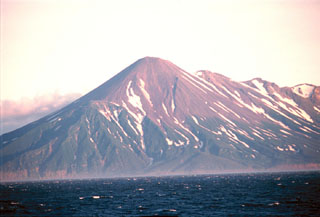Report on Chikurachki (Russia) — July 2003
Bulletin of the Global Volcanism Network, vol. 28, no. 7 (July 2003)
Managing Editor: Edward Venzke.
Chikurachki (Russia) Infrequent observations suggest weaker eruptions continued in July 2003
Please cite this report as:
Global Volcanism Program, 2003. Report on Chikurachki (Russia) (Venzke, E., ed.). Bulletin of the Global Volcanism Network, 28:7. Smithsonian Institution. https://doi.org/10.5479/si.GVP.BGVN200307-290360
Chikurachki
Russia
50.324°N, 155.461°E; summit elev. 1781 m
All times are local (unless otherwise noted)
The eruption of the Chikurachki volcano that began on 18 April 2003 continued into mid-July. Ash explosions, possibly up to 4 km above the crater, diminished, and by 3 July only rose up to 2 km above the crater. The volcano is remote, being ~60 km from Severo-Kurilsk on Paramushir Island. It also lacks seismic instruments, and the Kamchatka Volcanic Eruptions Response Team (KVERT) receives only occasional reports from Severo-Kurilsk.
According to a report from Leonid Kotenko of Severo-Kurilsk, ash explosions up to 500 m above the crater were observed from Shelekhov bay during 1930-2310 on 27 May. Ash plumes extended 70-80 km to the NE. At 0900 on 28 May, an ash plume rose 4 km above the crater and extended over 100 km to the NE. From 1030 on the same day, the plume heights decreased to 500 m above the crater. On 29 May, low-level ash plumes extended 15-20 km to the NE. In the afternoon of 29 May, an ash plume rose ~1.2 km above the crater, extended over Severo-Kurilsk, and ash fell on the town. Explosions occurred continually.
MODIS (moderate resolution imaging spectroradiometer) Terra and Aqua Goddard images from 1105 and 1235 on 30 May, depicted a faint, small ash cloud trending to the E. Clouds obscured the volcano on the other days in later May.
Kotenko reported on 6 June that the eruption continued. On 8 June, an ash plume extended 25-30 km to the SSE. On 9-10 June, the plume did not rise more than 500 m above the volcano and extended SSE. Ash fell on the Podgorny settlement, located at a distance of ~20 km SSE of the volcano. The observers from Shelekhov bay had noted more strong explosions during the night than in the day-time.
In the AVHRR (advanced very-high resolution radiometer) image at 1308 on 6 June, a narrow weak ash plume was observed extending to the SE for about 100 km from the volcano. In MODIS Goddard Terra images at 1100 on 8 June and at 1145 on 9 June, a narrow plume was seen extending to the SE for ~100 km. In the AVHRR image at 1245 on 9 June, this plume was also seen, but no ash was detected. Clouds obscured the volcano on the other days.
According to observers from Shelekhov settlement, on 15-16 June an ash plume was observed constantly at the volcano summit. The plume did not rise upwards, but was bent down the flanks of the volcano by a strong wind. On 17 June, observers saw a short gas-steam plume bent by a gale-force wind. On 18 June, Kotenko reported that the eruption continued. On other days, clouds obscured the volcano and prevented observation. According to the last report from Severo-Kurilsk, on 17-25 June, when the weather was good, fishermen from Shelekhovo bay observed only gas-steam activity from the volcano.
By 3 July, KVERT reported that the eruption of Chikurachki had possibly finished. According to satellite data from the USA and Russia, no activity of the volcano was noted from 25 June through 11 July.
Geological Summary. Chikurachki, the highest volcano on Paramushir Island in the northern Kuriles, is a relatively small cone constructed on a high Pleistocene edifice. Oxidized basaltic-to-andesitic scoria deposits covering the upper part of the young cone give it a distinctive red color. Frequent basaltic Plinian eruptions have occurred during the Holocene. Lava flows have reached the sea and formed capes on the NW coast; several young lava flows are also present on the E flank beneath a scoria deposit. The Tatarinov group of six volcanic centers is located immediately to the south, and the Lomonosov cinder cone group, the source of an early Holocene lava flow that reached the saddle between it and Fuss Peak to the west, lies at the southern end of the N-S-trending Chikurachki-Tatarinov complex. In contrast to the frequently active Chikurachki, the Tatarinov centers are extensively modified by erosion and have a more complex structure. Tephrochronology gives evidence of an eruption around 1690 CE from Tatarinov, although its southern cone contains a sulfur-encrusted crater with fumaroles that were active along the margin of a crater lake until 1959.
Information Contacts: Olga Girina, Kamchatka Volcanic Eruptions Response Team (KVERT), a cooperative program of the Institute of Volcanic Geology and Geochemistry, Far East Division, Russian Academy of Sciences, Piip Ave. 9, Petropavlovsk-Kamchatsky, 683006, Russia, the Kamchatka Experimental and Methodical Seismological Department (KEMSD), GS RAS (Russia), and the Alaska Volcano Observatory (USA); Alaska Volcano Observatory (AVO), a cooperative program of the U.S. Geological Survey, 4200 University Drive, Anchorage, AK 99508-4667, USA (URL: http://www.avo.alaska.edu/), the Geophysical Institute, University of Alaska, PO Box 757320, Fairbanks, AK 99775-7320, USA, and the Alaska Division of Geological and Geophysical Surveys, 794 University Ave., Suite 200, Fairbanks, AK 99709, USA.

